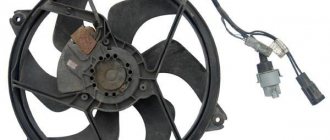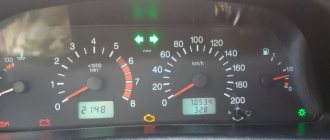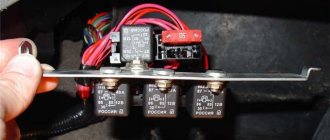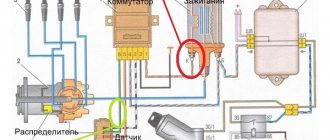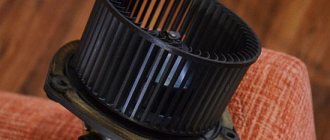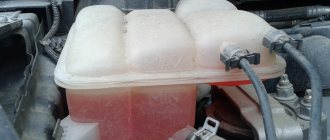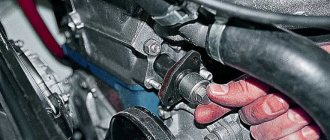The engine cooling system of a modern car is a complex mechanism equipped with passive and active components. Chevrolet Niva fan relays, responsible for turning on and off the specified elements.
Fuses help the electronics turn active cooling on and off to reduce powerplant temperatures.
System structure and principle of turning on fans
- The radiator and engine block are looped into a single system using pipes. Between them there is a rheostat - a damper with a temperature-sensitive element inside.
- When a certain temperature is reached, the damper opens and the liquid begins to circulate in a large circle.
- If passive cooling fails, the engine temperature rises. The head cooling fans come into play. When the temperature limit is overcome, the DTOZh sends an impulse to the BC.
- The processed signal closes the relay and the fan turns on. To improve system performance, the devices are paired. Dubbing helps prevent overheating if one of the devices breaks down. At the same time, the connection diagram for active coolers implies their simultaneous and separate activation.
The Chevrolet Niva interior heater fan is also used to cool the engine. Part of the system has a slight effect on the temperature, but in an emergency it can affect the operation of the engine.
Purpose and design
This is a module designed to be included in the on-board circuit of a motor that consumes high current. The fan motor is powered by electricity with a current of 20-35A, which is unacceptable for inclusion in a low-voltage control system - the wiring will melt. The Niva has only three relays, two for the left and right fans separately and one common. Each device has its own number in the on-board network. The principle of operation and purpose of the relay is relevant for cars of all types 2004, 2010, 2021 and other years of production.
Inside, the relays have an identical design. There is a low part, a transformer and a high part. Also two pairs of contacts, one normally closed, the second open. When a pulse is applied to the lower part, a magnetic field is formed on the windings, and the contact group on the high side closes - power is supplied to the fan motor.
The cooling screw operates in two modes. When the engine heats up to 99 degrees Celsius, the first fan is turned on, after passing the 101⁰C mark, the second one is connected. If the system cannot cope, the motors switch to higher speeds.
Fan relay diagram
The figure shows the power supply circuit for the electric fans of the cooling system of the installation. Design elements are presented by numbers.
- 1/7 – left and right fan motors;
- 2 – additional power relay;
- 3 – fuse;
- 4 – power controller;
- 5 – auxiliary resistor;
- 6/8 – main relay for turning on the right and left electric motor, respectively;
- A/C – negative/positive battery terminal;
- B – to the main ignition relay.
Pulley fan sensor
The coolant temperature sensor plays the role of supplying a pulse to turn on the fans. When a certain temperature is reached, the device sends a signal to the ECU and the fans are activated. In versions where the BC is located in the cabin, you can make adjustments to the sensor response threshold.
Purpose and functions
The device has a single role - to prevent boiling of the coolant and overheating of the power plant. Thus, turning on at a certain moment, the part equalizes the temperature of the engine and stabilizes its behavior.
Operating principle and location
The sensor works as follows.
- The temperature-sensitive sensor is programmed to pulse at a certain temperature.
- When the threshold is reached, the sensor sends a signal to the ECU and the first fan turns on.
- If the motor temperature rises further, the second relay is activated and the remaining fan is connected.
Job
The Shniva cooling system has two active cooling elements. There is a fan for the heater radiator and the main heat exchanger. The following information is relevant for cars of 2010 and other model years.
Fuses are responsible for the correct, stable operation of devices. Fuse links will protect the device from power surges and short circuits.
Pulley fan fuse: where is it located?
Located in close proximity to the corresponding relays. The stove insert is located in the main mounting block under number F18. A 25 amp fuse protects multiple circuits at once.
Main block with fuses and relays
This block is located to the left of the steering column and is closed from below with a lid. To get to it, you need to tighten 2 screws, then press the top edge of the cover and gradually free it from all fasteners.
The block that appears will be held on a special bracket. The fuse diagram itself and the number of elements on it may vary depending on the configuration and year of manufacture.
Also interesting: All-terrain vehicles with low-pressure tires
photo of the fuse box in a Chevrolet Niva
Possible malfunctions and their causes
If the fans do not turn on on time, the problem may be hiding in the following places.
- Relays or fuses have blown.
- DTOZH does not work correctly.
- The wiring of the device is damaged.
- Incorrect ECU settings.
- The fan motor is damaged or shorted.
Checking the functionality of the sensor, relays and fuses
The DTOZH is responsible for the operation of the fans; it is easy to check.
- Prepare a thermometer, multimeter, kettle or bowl of cool water.
- Immerse the sensor in a container and put it on fire, at the same time immerse the thermometer in water.
- When passing thresholds of 5 degrees, you should connect the multimeter to the sensor in resistance mode. At the same time, record the data.
- After heating the water to a boil, take the last measurements and compare the results with the reference table below. If the device indicators differ by more than 10% from the standard, the sensor is changed.
Forced activation of cooling fans
To make this possible, car enthusiasts install an additional switch into the device circuit and power it directly from the battery. The operation of the electronics is disrupted and the on-board computer may generate an error.
To fake the device, users on the network recommend using a circuit. A relay and a forced switch are added here.
Replacing the Fan Relay
Due to the simplicity of the design, the procedure is performed according to a standard scenario. Access to the mounting block is opened, the terminal of the relay contact group is disconnected. Next, the device is unscrewed from the panel and replaced with a new one.
Where is the fuse and relay box located on the Chevrolet Niva?
The fuse and relay box is located in one place, in the cabin and to the left of the steering column. Access to it is difficult, since the cover is screwed on and not on latches.
12.5.2 Replacing ball joints
12.5.1. Replacing ball joints
Before proceeding to replacing the ball joint, it must be carefully checked (see subsection 12.5.4).
When carrying out work to replace the hinge, unscrew the drive shaft nut. Since the weight of the car should not rest on a loose wheel bearing, the nut must be unscrewed after installing the car on supports.
The review talks about the Chevrolet Niva starter relay where the photo is located, compiled from the opinion and experience of car owners.
— loosen the wheel nuts and raise the car slightly;
— loosen the 12-sided nut of the drive shaft and separate the shaft from the wheel hub (see section 8);
The mounting block with fuses and relays on the Chevrolet Niva is mounted on special brackets to the left of the steering column and is closed from below with a lid. To access the mounting block, remove its cover by unscrewing the screws.
Price
Depending on the manufacturer, the cost of the relay ranges from 50-90 rubles per unit. Fuses are considered consumables and cost between 10-15 rubles/piece.
The Chevrolet Niva is an SUV. It has 5 passenger seats and runs on 95 gasoline. A huge advantage is that it is all-wheel drive, has high cross-country ability and has compact dimensions.
To maintain thermal conditions, the car is equipped with a cooling system. In order to maintain the optimal temperature in the vehicle, the Chevrolet Niva manufacturers have provided a cooling system. The most important part is the fan. It is designed to supply air through the radiator core. If the cooling fan breaks down, the machine overheats due to the accumulation of excess warm air inside. This vehicle, unlike other models, has two fans, which complicates the operation of the entire system. This article will tell you what to do if the cooling fan on a Chevrolet Niva does not turn on.
It is enough to simply determine if the cooling fan is broken:
- the temperature arrow will be in the red area;
- The cooling system and fan will not function.
If the cooling fan does not turn on on a Niva Chevrolet car, it is necessary to identify the cause of this phenomenon and eliminate it in the future.
Possible reasons
Before repairing or replacing the cooling fan on a Chevrolet Niva, it is necessary, as already noted, to understand the reasons why this problem could occur. The first step is to inspect the front panel fuse. As a rule, it is located in the mounting block, on the passenger seat side. Two fuses take part in the air cooling process. At the same time, if the right one breaks down, both stop functioning, and if the left one breaks down, the right one still works.
The mounting block contains three relays. Each of them is responsible for a different speed of the cooling fan. If the low speed relay burns out, then the fan only works at maximum power. At the same time, by setting it to a low speed, it will heat up. There is also another additional fuse in the car that supplies power to the relay. If it malfunctions, the entire system will fail completely.
Removing and replacing the fan resistor
Before starting work, you must go to the inspection hole and remove the terminal from the battery. For repairs you will need 10-13 wrenches, a screwdriver and a new resistor. The part is installed in the beam below the radiator. The removal procedure is as follows:
- Unscrew the fastening bolts and remove the crankcase protection along with the mudguard.
- Remove the protective strip of the resistor and unscrew the part.
Assembly is performed in reverse order.
How do fans work on a Chevrolet Niva?
Causes of malfunction
The first thing you should pay attention to when the system is not working is the state of the fuses, which are located under the front panel, on the passenger side, in a special mounting block. A pair of fuses are responsible for the cooling operation; if the right one fails, then both fans stop working, and if the left fuse blows, then one element can continue to operate.
In addition, the mounting block has three relays that are responsible for operating the fans at different speeds. And if the relay responsible for operation at low speeds burns out, then the cooling system works correctly only at high speeds, and at low speeds the engine begins to heat up. Power is supplied to the relay through a special fuse, which can also fail, causing system failure.
Failure of temperature sensors also affects proper cooling operation. They are located on the engine. They operate when the desired temperature is reached, one when it reaches 90 degrees, and the second when it reaches 101 degrees. It is recommended to start checking with them, this is done this way: the connector is disconnected from the electric motor, and power is supplied to them directly through the battery; if the electric motor is running, then the reason is in the sensors.
If after checking everything, fuses, relays and sensor are in order, you should pay attention to the fans.
Pump failure
A pump is a water pump that is necessary to circulate coolant throughout the system. The pump on the Niva is driven by a drive belt. If the belt breaks, the engine will not only be left without cooling, but will also lose charge from the generator.
But the pump fails not only because of the belt. The main reason for the breakdown of the water pump on the Niva is the breakdown of the impeller. As a result, circulation is disrupted and the engine begins to heat up at idle speed. When the speed increases, the engine may cool down.
Checking and removing fans
To understand whether they work or not, you need to disconnect the connector from their motors, and connect a lamp to the wires through which voltage is supplied; we do the same with the sensor; if both lamps light up, then the problem is in the fans.
To remove them you need to do the following:
- Disconnect all wires
- Removing the upper pipe
- Removing the bumper
- If there is an air conditioner, bend the tubes (this must be done carefully, as they may burst) or drain the freon (filling it back will not be cheap), then remove the air conditioner radiator.
- You need to loosen the nuts on the radiator casing
- Tilt the radiator so that you can remove the fan unit
- Unscrew the bolts that secure the block and remove it
After removal, it is recommended to immediately replace both with new ones, since there is a possibility that a little time will pass and the second element will fail and all replacement work will need to be done again. You can do this procedure from below, but you will need special equipment, and you will need to move the engine ten centimeters back, which is very labor-intensive.
Everyone knows that modern cars have a water engine cooling system in their design, which allows many times to increase the service life of not only the engine, but also the entire mechanism as a whole. The Chevrolet Niva also has a radiator in its design that is filled with coolant. This liquid circulates through the system, thereby cooling the car engine. But the engine temperature exceeds 100 degrees, so if this liquid is not cooled, it will soon turn from cooling to heating. This is precisely why there is a radiator cooling system, the operation of which is carried out by a fan. But since the Chevrolet Niva is equipped with a powerful 1.7-liter engine, two fans are used to cool the radiator. In this article, we will look at how these devices work, or rather, what is the main element of turning on these devices on a Chevrolet Niva SUV.
Fan switching principle
The cooling fan is powered by a constant voltage of 12 V from the battery. They turn on when two sensors located in the engine reach a certain temperature. So, when the first sensor reaches a temperature of 99 degrees Celsius, it is triggered, which causes the first fan to turn on. It has two rotation speed positions - high and low rotation speeds. When the second sensor reaches a value of 101 degrees, then, accordingly, the second device turns on. Thus, the cooling devices of the Chevrolet Niva engine are briefly activated. But we are interested in what role such a small device as a relay, of which there are three on the Chevrolet Niva, plays in this process.
Relay purpose and design
The relay is designed for switching large load currents. This is a rather complex formulation, so in simple terms, a relay is necessary in order to be able to control electrical circuits where there are large currents. The electric motor of the cooler consumes direct current, the value of which is 20-30 amperes, which means that if it is included in the control circuit (where small currents pass), then all the electronics will fail (the wiring will melt). That is why such an important control element is installed in the design of cars.
Externally, the product is a plastic base, inside of which the mechanism itself is located. There are five (four) contacts on the back side of the base. They are the basis for including a relay in the control circuit.
Inside, the relay mechanism is presented in the form of a coil with a core - it is also the basis for closing the circuit contacts. In the photo below you can see the appearance of the Chevrolet Niva product.
The principle of operation of the device and its placement on the Chevrolet Niva
On the front part of the product there is a diagram of the arrangement of contacts, according to which we will consider its principle of operation.
Contacts "85" and "86" are the coil terminals.
General contact “30” - without voltage present on the winding, is always in the closed position to contact “87a”. In turn, contacts:
- “87a” – normally closed;
- “87” – normally open.
It is to these contacts that the power cables from the fan motor are connected.
When power is applied to contacts “85” and “86”, the coil relay is activated. Thus, contact “30” opens from “87a” and closes to “87”. Thus, power is supplied to the electric motor of the device. The activation process takes a fraction of a second.
So, when the temperature in the engine rises, the sensor is triggered and sends an impulse to the control circuit. In turn, voltage is induced in the circuit, which is not supplied by the relay, but it turns on the direct cooling device.
A relay is a replaceable part that, if it fails, requires replacement, but not repair. Some craftsmen are trying to repair them, but there is no need for this, since one product costs from 50 to 80 rubles (depending on the manufacturer).
For Chevrolet Niva, it is recommended to use a relay made in Russia. They are the optimal solution for VAZ family cars.
Before replacing the relay, you will need to find it, because by design it is a small plastic box. Where are the fan relays on the Chevrolet Niva? To answer this question, it is worth noting that there are two cooling devices on the Chevrolet Niva, so the corresponding relay is responsible for the operation of each.
So, having discovered a malfunction in the car’s cooling system, it is worth paying attention to the suitability of the relay. But first they must be removed from the installation site. To do this, you need to open the right front door of the Shevik and look from underneath at the dashboard. It is there, under the cover of the mounting block, that the fan and fuel pump control relays, as well as the fuses for these devices, are located. In the photo below you can see where the control switches are located: right and left, as well as the low speed fan.
To remove the device from its seat, you need to pull it out of the installed socket. To do this, grab the product with one hand and pull. After removing it, do not rush to buy a new relay, as the problem may lie elsewhere. To do this, it is worth checking its performance.
The fan on the Chevrolet Niva does not work, or constantly works
The favorable thermal regime of the Chevrolet Niva SUV engine is supported by a cooling system, in which two serviceable fans play a significant role, providing the required air flow through the radiator core. If the fans fail, the cooling system cannot cope with removing excess heat from the engine, and it begins to overheat. Due to the fact that the number of fans on the Chevrolet Niva has been doubled, the electrical circuit for turning them on has become more complex than on conventional passenger cars.
If the temperature gauge needle is near the red part of its scale, and the engine cooling system fans do not turn on, then you will have to stop and start looking for this malfunction. To do this, you will need to remove the cover of the additional mounting block located under the front panel (below the glove compartment) in the area where the front passenger's feet are located. There are two fuses protecting the electrical circuits of the fan motors. If the fuse protecting the circuit of the right electric motor blows, both fans will not turn on, and if the second blows, only the left fan will not turn on.
In the same block, there are three relays that are responsible for turning on the right fan at low and high rotation speeds and turning on the left fan at high rotation speed. The additional relay should operate when a control signal is applied to its terminal No. 86 from terminal No. 46 of the electronic control unit (ECM). In this case, voltage will be supplied to the fan motor terminals through a resistor. If the resistor burns out or this relay fails, the low speed fan will not work.
The right fan relay is activated when a control signal is received at its terminal No. 86 from terminal No. 6 of the electronic control unit (ECM). In this case, the fan should start operating at high rotation speed. If there is no control signal or this relay is faulty, the right fan will not turn on. The same control signal also turns on the left fan, since there is a jumper between terminals No. 86 and No. 85 of the right and left fan relays. But power to the left fan motor goes through its own fuse.
Also, both fans will not turn on if the coolant temperature sensor (CTS) fails. Since it is based on his data on the temperature of the antifreeze that the controller’s decision to turn on or not turn on the fans depends.
Due to the increased temperature inside the engine compartment, there are cases of deformation of the plastic fan casings, and when they are turned on, the rotating fan blades touch the casing. As a result, the tips of the blades are heated to their melting temperature. When the fans are turned off, the blades are welded to the casing and the next time they are turned on they will not work.
Another possible problem is that the fans start working immediately after the ignition is turned on, when the antifreeze in the engine cooling system is still cold. This happens for the following reasons:
- loss of contact on the block or in the wiring harness going from the coolant temperature sensor to the ECM, because if you remove the connector from this sensor, then if the electrical circuits of the fans are working, they should both work;
- “glitch” (malfunction) of the ECM controller;
- sticking contacts of the fan relay (but the likelihood of sticking contacts on three relays at once is very small);
